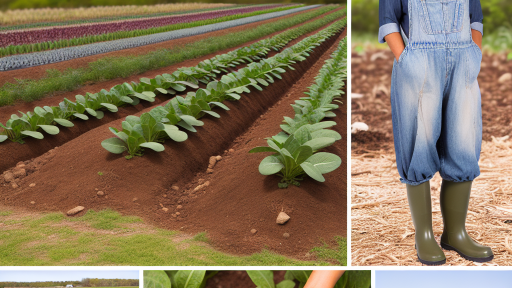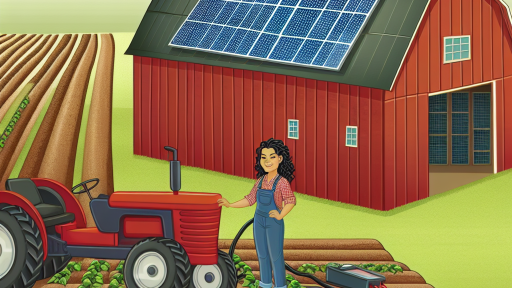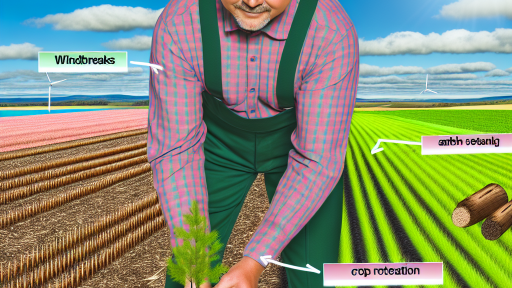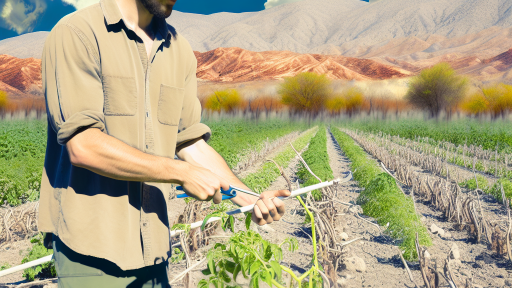Introduction to Low-Emission Farming
Importance of Low-Emission Farming
Low-emission farming plays a crucial role in combating climate change.
This approach significantly reduces greenhouse gas emissions.
Farmers can adopt innovative practices to achieve sustainability.
Moreover, it encourages the responsible use of resources.
Benefits of Low-Emission Farming
Enhancing soil health is one key advantage of low-emission farming.
Healthy soils contribute to higher crop yields and resilience.
Additionally, this method helps in preserving biodiversity in ecosystems.
Farmers can also enjoy reduced input costs over time.
Furthermore, consumers increasingly prefer sustainably produced goods.
Impact on the Environment
Low-emission farming practices contribute to cleaner air and water.
They help minimize pollutants that harm aquatic and terrestrial life.
Implementing these techniques supports overall ecosystem health.
In the long run, it fosters a more sustainable agricultural landscape.
Precision Agriculture: Utilizing Technology to Optimize Inputs and Reduce Waste
Introduction to Precision Agriculture
Precision agriculture employs innovative technologies to enhance farming efficiency.
This approach allows farmers to use resources more effectively.
Transform Your Agribusiness
Unlock your farm's potential with expert advice tailored to your needs. Get actionable steps that drive real results.
Get StartedMoreover, it helps minimize environmental impacts.
Key Technologies in Precision Agriculture
One key technology is GPS-guided machinery.
This machinery enables precise planting and field monitoring.
Additionally, drones are increasingly popular for crop surveillance.
They provide real-time data on crop health and conditions.
Furthermore, soil sensors offer valuable insights into nutrient levels.
These technologies work together to optimize inputs.
Optimization of Inputs
Farmers can use variable rate technology (VRT) for efficient resource application.
VRT allows differential application of water, fertilizers, and pesticides.
Consequently, farmers tailor treatments to specific field zones.
This method significantly reduces excess input waste.
Reducing Waste through Data Analytics
Data analytics plays a crucial role in precision agriculture.
Farmers analyze data to improve decision-making processes.
This analysis helps predict crop yields accurately.
Moreover, it enhances resource allocation and management strategies.
Environmental Benefits
Implementing precision agriculture contributes to sustainability.
Reduced chemical runoff protects local waterways.
Additionally, lower fuel consumption enhances energy efficiency.
This method promotes ecological balance and health.
Case Studies of Successful Implementation
Many farmers report success using precision techniques.
For instance, GreenField Farms increased their productivity by 30%.
By using precision farming tools, they minimized fertilizer use dramatically.
Similarly, EcoHarvest Co. adopted drone technology for monitoring.
This change reduced labor costs and improved crop health assessments.
Showcase Your Farming Business
Publish your professional farming services profile on our blog for a one-time fee of $200 and reach a dedicated audience of farmers and agribusiness owners.
Publish Your ProfileAgroecology: Integrating Ecological Principles for Sustainable Farming
Defining Agroecology
Agroecology combines agriculture and ecology.
It focuses on sustainable farming practices.
This approach promotes biodiversity and ecosystem health.
Farmers can enhance soil fertility and resilience.
Principles of Agroecology
Agroecology is guided by several key principles.
These include diversity, synergy, and resilience.
Diversity improves crop yields and pest resistance.
Synergy promotes beneficial interactions among farm organisms.
Moreover, resilience enables farms to adapt to climate change.
Practices in Agroecology
Various practices are essential for implementing agroecology.
- Crop rotation diversifies plant species in fields.
- Intercropping improves nutrient usage.
- Permaculture designs mimic natural ecosystems.
- Cover cropping enhances soil structure and health.
Benefits of Agroecological Practices
Adopting agroecological practices yields multiple benefits.
First, it reduces the reliance on chemical fertilizers.
Additionally, it lowers greenhouse gas emissions from farming.
Consequently, agroecology promotes healthier food systems.
Finally, it supports local economies and farmers’ livelihoods.
Challenges and Solutions
Despite its advantages, agroecology faces challenges.
Farmers may need education and training on new methods.
Access to resources can also be limited.
To overcome these hurdles, collaboration is essential.
Communities can share knowledge and resources.
Government policies can provide support and incentives.
You Might Also Like: Best Practices for Climate-Smart Crop Cultivation
Cover Cropping: Enhancing Soil Health and Reducing Carbon Emissions
Introduction to Cover Cropping
Cover cropping plays a vital role in modern agriculture.
This practice involves planting specific crops to cover the soil.
Farmers use it to protect and enhance soil health.
Moreover, cover crops can significantly reduce carbon emissions.
Benefits of Cover Cropping
First, cover crops improve soil structure and fertility.
They add organic matter to the soil as they decompose.
This process enriches the nutrient content available for crops.
In addition, they prevent soil erosion during heavy rains.
This occurs because their roots hold the soil in place.
Carbon Sequestration Potential
Cover crops play a crucial role in sequestering carbon dioxide.
As they grow, they absorb carbon from the atmosphere.
This helps mitigate climate change effects.
When cover crops decay, they store carbon in the soil.
Thus, they contribute to long-term carbon storage solutions.
Choosing the Right Cover Crops
Selecting suitable cover crops is essential for success.
Farmers can choose from various species based on their goals.
- Legumes, such as clover, fix nitrogen, enhancing soil fertility.
- Grasses, like rye, prevent erosion and improve soil structure.
- Brassicas, such as radishes, help break up compacted soil.
Implementing Cover Crops in Farming
Farmers can adopt cover cropping with careful planning.
They should consider the season and main crops when planting cover crops.
Showcase Your Farming Business
Publish your professional farming services profile on our blog for a one-time fee of $200 and reach a dedicated audience of farmers and agribusiness owners.
Publish Your ProfileAdditionally, incorporating cover crops into crop rotation is beneficial.
This diversity enhances ecosystem resilience and productivity.
Sustainable Practices and Innovation
Many farms are now integrating technology with cover cropping.
Precision agriculture tools can aid in managing cover crops effectively.
Data-driven decisions lead to better outcomes and reduced emissions.
Moreover, farmers share successful techniques to inspire others.
You Might Also Like: Carbon Sequestration’s Impact on Farm Profits
Technology in Livestock Management
Reducing Methane Emissions through Smart Practices
Innovative technology plays a crucial role in managing livestock effectively.
Farmers are increasingly adopting smart technologies to reduce methane emissions.
These technologies enhance livestock health and improve productivity.
They also enable better resource management and environmental sustainability.
Precision Livestock Farming
Precision livestock farming utilizes advanced sensors and data analytics.
Farmers can monitor animal health and behavior in real-time.
This approach identifies issues early, reducing stress and emissions.
For example, wearables track vital signs and diet intake.
As a result, farmers can adjust feed formulations to reduce methane output.
Improved Nutrition Management
Nutrition significantly impacts methane production in livestock.
Technology enables farmers to formulate optimal diets for their animals.
This includes incorporating additives that inhibit methane production.
For instance, seaweed supplements can significantly lower emissions.
Furthermore, improved feeding strategies enhance digestion and nutrient absorption.
Manure Management Solutions
Effective manure management reduces greenhouse gas emissions.
Technological solutions like anaerobic digesters convert manure to biogas.
This process captures methane and turns it into renewable energy.
Additionally, composting methods can minimize odor and emissions.
Using technology, farmers can optimize nutrient recovery from manure.
Monitoring and Reporting Tools
Real-time monitoring tools provide valuable insights into livestock management.
These tools help track emissions consistently across the farm.
Reporting platforms simplify compliance with environmental regulations.
Farmers can better demonstrate their commitment to sustainability.
These tools empower farmers to make informed decisions.
Delve into the Subject: Implementing Biochar in Agriculture for Carbon Storage

Bioenergy and Renewable Resources
Utilizing Agricultural Waste
Agricultural waste represents a valuable resource for sustainable energy production.
Farmers can turn waste into energy, thereby reducing emissions.
This process utilizes by-products like crop residues and manure.
By converting waste into bioenergy, farmers enhance their profitability.
Moreover, it minimizes landfilling and promotes waste recycling.
Types of Bioenergy Sources
There are various forms of bioenergy derived from agricultural waste.
Common sources include biogas, bioethanol, and biodiesel.
Biogas is produced through anaerobic digestion of organic matter.
Showcase Your Farming Business
Publish your professional farming services profile on our blog for a one-time fee of $200 and reach a dedicated audience of farmers and agribusiness owners.
Publish Your ProfileBioethanol is generated by fermenting sugars found in crops.
Biodiesel is created from vegetable oils or animal fats.
Each type of energy has distinct benefits and applications.
Technological Innovations
Recent advancements have improved bioenergy production efficiency.
New technologies are enhancing anaerobic digestion processes.
For instance, advanced microbial strains are being utilized.
These strains significantly boost biogas yields.
Additionally, integrated systems combine different bioenergy technologies.
These systems optimize resource use and reduce processing costs.
Case Studies of Successful Practices
Several farms have successfully implemented bioenergy solutions.
Greenfield Farms in Iowa turned waste into renewable natural gas.
This initiative reduced greenhouse gas emissions by 50%.
Sunny Acres in California uses crop residues for bioethanol production.
They have increased their revenue while decreasing reliance on fossil fuels.
Challenges and Solutions
Despite the benefits, challenges exist in adopting bioenergy solutions.
These include initial investment costs and technical expertise.
However, government incentives can offset costs for farmers.
Additionally, cooperative models can share resources and knowledge.
Such strategies enable more farms to adopt these innovative techniques.
See Related Content: Adapting Farming Practices to Changing Water Patterns
Regenerative Agriculture: Restoring Soil Health and Increasing Carbon Sequestration
Understanding Regenerative Agriculture
Regenerative agriculture focuses on rebuilding soil health.
This method emphasizes practices that enhance ecosystem functions.
Additionally, it seeks to restore agricultural landscapes through natural processes.
Key Practices in Regenerative Agriculture
Crop rotation plays a crucial role in soil health.
This technique prevents nutrient depletion and reduces pest issues.
Cover cropping also enhances soil structure and fertility.
Furthermore, agroforestry integrates trees with crops for added benefits.
This practice improves biodiversity and enhances carbon storage.
- Minimizing tillage preserves soil structure.
- Integrating livestock promotes nutrient cycling.
- Implementing compost enriches soil microbial populations.
Benefits of Regenerative Agriculture
Regenerative agriculture significantly increases carbon sequestration.
Healthy soils capture more atmospheric carbon dioxide effectively.
This process combats climate change by reducing greenhouse gases.
Furthermore, it improves water retention in the soil.
This enhancement mitigates drought effects in farming areas.
Additionally, healthier soil leads to higher crop yields and resilience.
Impact on Soil Health
Restoring soil health boosts its biological activity.
A diverse microbial community is vital for nutrient cycling.
Moreover, improved soil structure facilitates better root growth.
This results in stronger plants and less susceptibility to disease.
In turn, healthy plants produce higher-quality food for consumers.
Case Studies and Success Stories
Successful regenerative farms demonstrate tangible benefits.
Showcase Your Farming Business
Publish your professional farming services profile on our blog for a one-time fee of $200 and reach a dedicated audience of farmers and agribusiness owners.
Publish Your ProfileFor instance, Green Valley Farm in California saw increased yields.
They adopted crop rotation and cover cropping to enhance soil health.
Similarly, Willow Creek Ranch in Oregon implemented agroforestry techniques.
This integrated approach reduced chemical input while boosting biodiversity.
These examples showcase the potential of regenerative practices.
Farmers worldwide can learn and adapt these techniques for their benefit.
Government Policies and Supporting Programs for Innovative Low-Emission Practices
Overview of Government Initiatives
Governments worldwide are implementing initiatives to reduce agricultural emissions.
These initiatives aim to promote sustainable farming methods.
Policies often include financial incentives for adopting low-emission practices.
Furthermore, governments partner with agricultural organizations to facilitate these changes.
Subsidies and Financial Support
Subsidies play a vital role in encouraging low-emission farming practices.
Farmers receive financial assistance to invest in sustainable technologies.
This investment includes equipment for efficient fertilizer application.
Additionally, funding for renewable energy sources supports emission reductions.
- Solar panels for powering farm operations.
- Wind turbines for sustainable energy generation.
- Biogas systems for waste management and energy production.
Research and Development Grants
Governments allocate specific grants for agricultural research and development.
These grants enable researchers to explore innovative farming techniques.
For example, they can study cover cropping and its benefits for soil health.
Such initiatives enhance the agricultural sector’s sustainability.
Moreover, public-private partnerships often drive these research efforts.
Education and Training Programs
Educating farmers about low-emission practices is essential for success.
Government programs provide training sessions and workshops.
These programs focus on best practices for reducing emissions.
Farmers learn about crop rotation and integrated pest management.
Additionally, information on using precision agriculture tools is available.
Collaboration with Non-Governmental Organizations
Governments collaborate with NGOs to enhance low-emission farming efforts.
These partnerships often focus on community-based initiatives.
NGOs assist in implementing projects that promote sustainable practices.
For instance, they can help farmers access markets for organic products.
This collaboration also raises public awareness about sustainable agriculture.
Global Cooperation and Agreements
International agreements set standards for low-emission farming practices.
Countries commit to reducing greenhouse gas emissions through these agreements.
Collaborative efforts foster innovation in sustainable agricultural techniques.
This global approach encourages knowledge sharing among nations.
Ultimately, it aims for a greener future in global farming.
Additional Resources
USDA Science and Research Strategy, 2023-2026: Cultivating …




